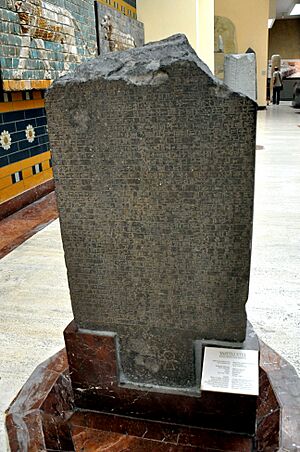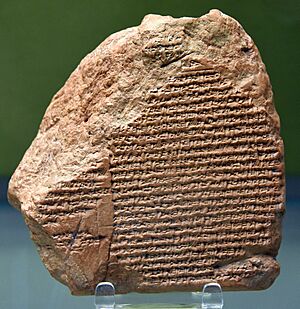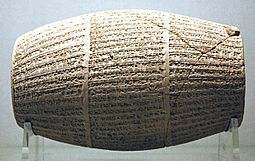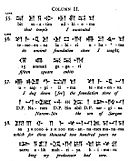Nabonidus facts for kids
Quick facts for kids Nabonidus |
|
|---|---|
|
|
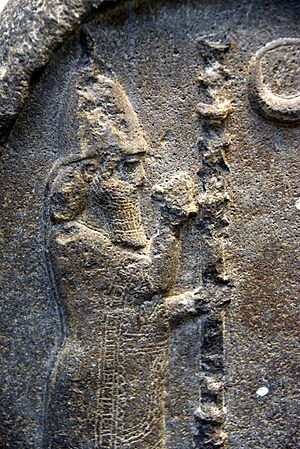
Nabonidus, detail of a stele in the British Museum, probably from Babylon, Iraq
|
|
| King of the Neo-Babylonian Empire | |
| Reign | 25 May 556 BC – 13 October 539 BC |
| Predecessor | Labashi-Marduk |
| Successor | Cyrus the Great (Achaemenid Empire) |
| Born | c. 620–615 BC Harran |
| Died | Possibly after 522 BC Carmania (?) |
| Spouse | Nitocris (?) (A daughter of Nebuchadnezzar II) (?) |
| Issue Among others |
Belshazzar Ennigaldi-Nanna Ina-Esagila-remat Akkabuʾunma |
| Akkadian | Nabû-naʾid |
| Dynasty | Chaldean dynasty (through marriage) (?) |
| Father | Nabu-balatsu-iqbi |
| Mother | Adad-guppi |
Nabonidus (Babylonian cuneiform: ![]() Nabû-naʾid) was the last king of the Neo-Babylonian Empire. His name means "May Nabu be exalted" or "Nabu is praised". He ruled from 556 BC until 539 BC. This was when the Achaemenid Empire, led by Cyrus the Great, conquered Babylon.
Nabû-naʾid) was the last king of the Neo-Babylonian Empire. His name means "May Nabu be exalted" or "Nabu is praised". He ruled from 556 BC until 539 BC. This was when the Achaemenid Empire, led by Cyrus the Great, conquered Babylon.
Nabonidus was the last native ruler of ancient Mesopotamia. His reign ended thousands of years of independent states and empires there. He was also the last independent king of Babylon. Many historians see Nabonidus as a unique and strong ruler. Some even call him an unusual religious reformer and the first archaeologist.
Contents
Who Was King Nabonidus?
Family and Early Life
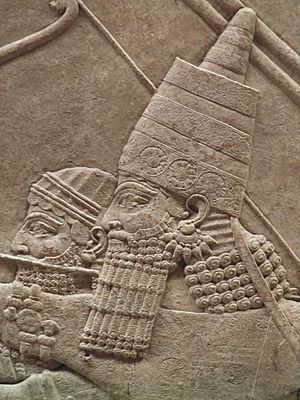
Nabonidus's background is a bit of a mystery. He never said he was related to earlier kings. This suggests he wasn't part of the Chaldean dynasty that ruled Babylon before him.
His mother, Adad-guppi, was from Assyria. She was born around 648/649 BC. She was an important person in the royal court of Babylon. She claimed to have influenced kings like Nabopolassar and Nebuchadnezzar II. Adad-guppi was likely from Harran in northern Mesopotamia. She was also a priestess for the moon god, Sîn.
Nabonidus's father was Nabu-balatsu-iqbi. Not much is known about him. Nabonidus called his father a "learned counsellor" and "wise prince." This means his father was likely a noble or important person.
Some historians think Nabonidus's parents might have been part of the Sargonid dynasty. This was a powerful family that ruled the Neo-Assyrian Empire. However, there is no strong proof for this idea.
It's believed that Nabonidus was an only child. His mother, Adad-guppi, claimed to have seen her great-great-grandchildren. This means Nabonidus must have been born around 615 BC or even earlier.
Nabonidus might have married one of Nebuchadnezzar II's daughters. This marriage could explain how he became king. It would also connect his son, Belshazzar, to the royal family. Some ancient texts, like the Book of Daniel, say Belshazzar was Nebuchadnezzar II's grandson.
Before Becoming King
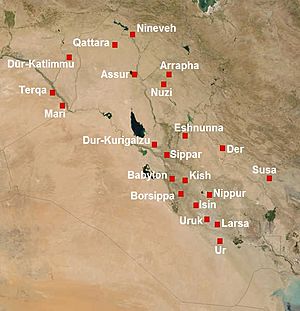
Before becoming king, Nabonidus was not widely known in historical records. One ancient Greek historian, Herodotus, mentions a "Labynetus" (another name for Nabonidus). This person was a mediator for Babylon in 585 BC. It's possible this was the future king.
Some documents mention a Nabonidus as an official in charge of a city. This was around 597 BC. If this was the same person, he would have been quite old when he became king.
The Babylonian historian Berossus said Nabonidus was a "priest of Bêl." This religious role might explain why he wasn't often mentioned in earlier documents. His mother, Adad-guppi, said she introduced Nabonidus to kings Nebuchadnezzar II and Neriglissar. She said he served them well.
Nabonidus's Time as King
How He Became King

Nabonidus became king after the previous ruler, Labashi-Marduk, was removed from power. Labashi-Marduk was the son of Neriglissar, who was Nebuchadnezzar II's son-in-law. Labashi-Marduk ruled for only a few months in 556 BC. Ancient texts say he was killed in a plot.
Nabonidus likely played a big part in this plot. He had strong support from the Babylonian army. Even though he claimed he didn't want to be king, he accepted the role.
His son, Belshazzar, was probably the main person behind the plot. Belshazzar became the chosen heir to the throne. He also inherited Labashi-Marduk's wealth. Belshazzar likely thought that by putting his older father on the throne, he would secure his own future as king.
Early Years of His Rule
One of Nabonidus's first acts as king was visiting the city of Sippar. He made donations to the city's temple. This visit might have been to show his authority, as Sippar had recently recognized the previous king.
In late 556 BC, Nabonidus led the Babylonian army on a campaign. He went to Hume in eastern Cilicia. This was a successful military action. Prisoners and treasures were brought back to Babylon. He also visited cities in southern Babylonia, like Kish and Ur.
Nabonidus's main building project was restoring the Ekhulkhul temple in Harran. This temple was dedicated to the moon god Sîn. It had been destroyed by the Medes in 610 BC. Nabonidus felt it was his destiny to rebuild it. He believed the gods, Marduk and Sîn, had told him to do so in a dream.
Nabonidus's Stay in Tayma

In 553 BC, Nabonidus went on a military campaign to Arabia. He conquered the city of Tayma. Then, he stayed there for about ten years, until 543 or 542 BC. This long stay in Tayma is a mystery to historians.
During his time in Tayma, Nabonidus rebuilt the city. He added new walls, buildings, and a royal palace. Archaeological digs at Tayma show that the city grew a lot during this time. There are signs of Babylonian influence in the ruins.
Why did he stay so long?
- Trade Routes: Tayma was on important trade routes. Controlling them would bring wealth to Babylon.
- Religious Reasons: Nabonidus was devoted to the moon god Sîn. Tayma had lunar deities. However, there's no clear evidence of Babylonian temples built there.
- Political Conflict: Some think he might have had disagreements with powerful groups in Babylon. His son, Belshazzar, ruled Babylon as regent during this time. Nabonidus himself blamed his stay on the "impiety of the Babylonians."
While Nabonidus was in Tayma, Cyrus the Great was building his large empire. Belshazzar in Babylon became worried about Cyrus's growing power.
Religious Changes
Nabonidus is known for trying to change religious practices in Babylonia. He seemed to want to make the moon god Sîn the most important god. This would have meant lowering the status of Marduk, Babylon's traditional main god.
Many of Nabonidus's inscriptions praise Sîn much more than Marduk. He gave Sîn many special titles, like "shining god" and "exalted god." He gave Marduk fewer titles than usual.
During his time in Tayma, his inscriptions seemed to return to more traditional worship of Marduk. This might have been because Belshazzar, as regent, wanted to avoid problems with the priests in Babylon.
After returning to Babylon, Nabonidus became even more determined to promote Sîn. He gave Sîn Marduk's traditional titles, like "king of the gods." He even suggested that Marduk's main temple in Babylon was originally meant for Sîn. This was a big change, as Marduk had been the supreme god for centuries.
Not all historians agree that Nabonidus was trying to completely replace Marduk. Some believe he was just very religious and supported Marduk like other kings. They suggest that later writings, especially by Cyrus the Great, might have made Nabonidus seem more extreme for political reasons.
End of His Reign and Fall of Babylon
It's not clear why Nabonidus returned from Tayma. Perhaps he feared Cyrus the Great, or had disagreements with his son. Once back, he quickly pushed his religious changes. He completed the rebuilding of the Ekhulkhul temple in Harran. He saw this as his greatest achievement.
There might have been a famine in Babylonia during his later reign. Nabonidus thought it was Sîn's anger because people didn't accept his religious changes. The people, however, might have thought it was Marduk's anger at the king's new beliefs.
The New Year's festival, which honored Marduk, was restarted after Nabonidus returned. It had been stopped during his absence.
The threat from Cyrus the Great grew stronger. Nabonidus prepared for an attack. He brought statues of gods from other cities to Babylon for safety. This was a common practice during war.
In 539 BC, Cyrus invaded Babylonia. The battle of Opis was a major Persian victory. The Babylonian army suffered heavy losses. Soon after, Sippar surrendered to Cyrus without a fight. Nabonidus retreated to Babylon.
On October 12, the Persian army entered Babylon peacefully. The last record of Nabonidus's reign is from October 13. Persian soldiers guarded the temples, allowing priests to continue their duties. On October 29 or 30, Cyrus himself entered Babylon and became the new king.
What Happened to Nabonidus?
Historians have different ideas about what happened to Nabonidus.
- Some ancient Greek writers say he was killed when Babylon was captured.
- Others, like Berossus, say Nabonidus surrendered to Cyrus. They say Cyrus spared his life and sent him to live in Carmania (in modern Iran). If this is true, Nabonidus might have lived for many more years.
- The royal chronicle simply says he was captured in Babylon.
The fate of his son, Belshazzar, is also unknown. He was likely killed during the fall of Babylon.
Nabonidus's Family and Children
Nabonidus likely had a large family. His mother mentioned having great-great-grandchildren. This means Nabonidus would have had many descendants.
His known children include:
- Belshazzar: His son and crown prince. He ruled Babylon as regent when Nabonidus was in Tayma.
- Ennigaldi-Nanna: A daughter. She became a high priestess in the city of Ur.
- Ina-Esagila-remat or Ina-Esagila-risat: A daughter.
- Akkabuʾunma: A daughter.
Later, some people claimed to be Nabonidus's sons. They led rebellions against the new Persian rulers. However, these claims were likely false.
Nabonidus's Legacy
His Character and How He's Remembered
Nabonidus is seen in many different ways by historians. After Babylon fell, the Persian Empire criticized him. They said he was "heretical" and not a good king. Cyrus the Great used this to justify his conquest.
A legend grew that Nabonidus was mad because of his religious ideas. This story even appeared in later Jewish texts, but it was wrongly attributed to Nebuchadnezzar II. No ancient Babylonian texts actually say Nabonidus was insane. They describe him as unusual and misguided, but not mad.
Modern historians have also had different views. Some saw him as an old scholar who didn't care about ruling. Others saw him as a bad ruler whose actions led to the empire's fall. Some thought he was a religious fanatic.
Today, many historians see Nabonidus as a capable ruler. He tried to save the Neo-Babylonian Empire from its problems. He is called "the most individualist ruler of his time" because of his unique religious policies and his long stay in Arabia. He undertook many building projects and led successful military campaigns.
Nabonidus as an Archaeologist
Nabonidus is sometimes called the "first archaeologist." He dug up old foundations when restoring temples. This was to make sure the new temples were built exactly like the originals. He seemed more interested in history than previous kings.
His inscriptions mention earlier Babylonian and Assyrian rulers. He even tried to date them. For example, he estimated that Naram-Sin of Akkad lived 3200 years before his time. While his date was off by about 1,500 years, it was a very good guess for his era. This is the earliest known attempt to date an archaeological find.
When rebuilding a temple in Sippar, Nabonidus found a statue of Sargon of Akkad. He restored it out of respect for the gods and for kingship. This shows his interest in Sargon as a king and in the ancient Akkadian Empire. He also restored a temple and excavated a palace related to the Akkadian Empire.
Nabonidus also saw himself as a successor to the Assyrian kings. He called them his "royal ancestors." His archaeological work helped connect his empire to these older, powerful empires.
Royal Titles

Nabonidus used many traditional royal titles. Some of his titles were similar to those used by old Assyrian kings. This was unusual for Babylonian kings.
For example, in an inscription for Harran, he used these titles: "I am Nabonidus, the great king, the strong king, king of the Universe, king of Babylon, king of the Four Quarters, the restorer of Esagila and Ezida."
He also used more standard Babylonian titles, like: "Nabonidus, king of Babylon, the restorer of Esagila and Ezida, the performer of pious deeds, the son of Nabu-balatsu-iqbi, the perfect prince, am I."
These titles showed his power and his connection to both Babylonian and older Assyrian traditions.


